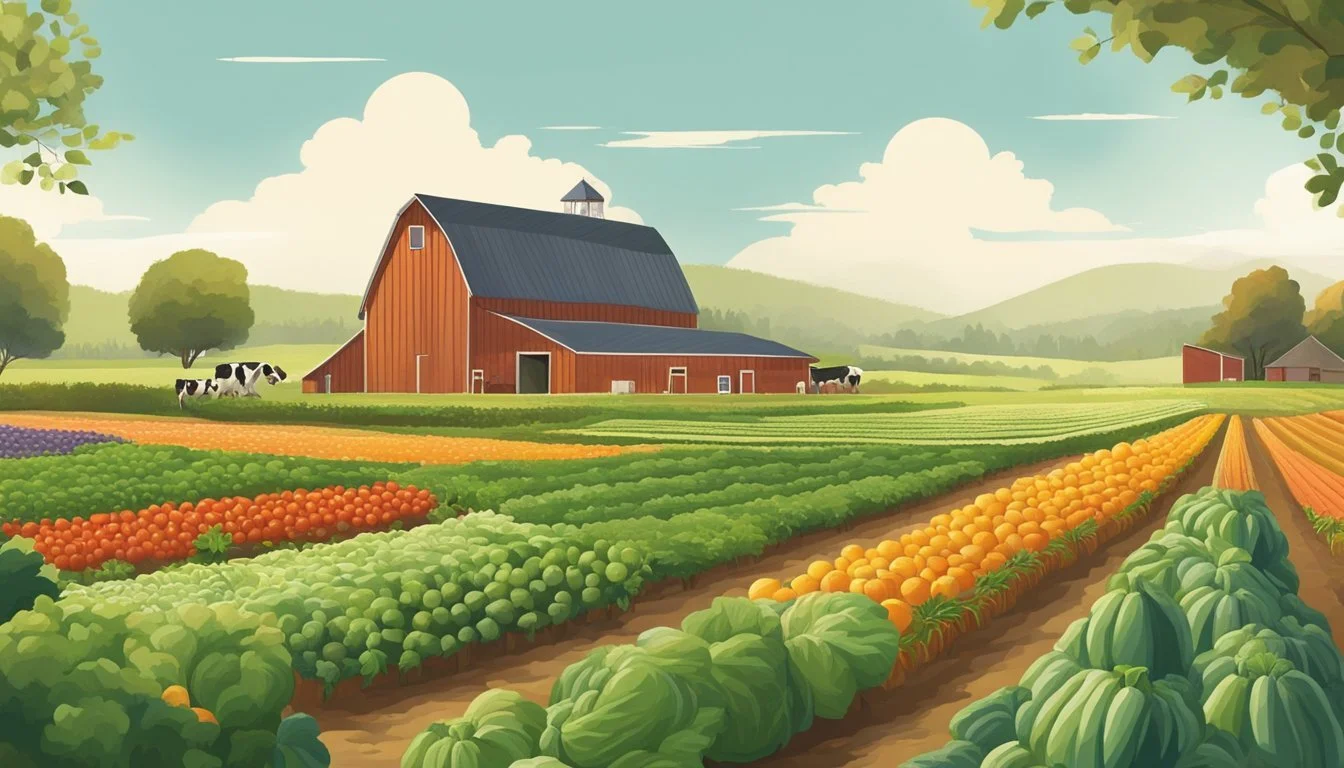The Role of Homesteads in Strengthening Local Food Systems
Homesteads play a critical role in local food systems, reinforcing the foundation for community-based agriculture and sustainable food production. These small-scale operations typically encompass gardening, livestock rearing, and various forms of food preservation, contributing to the resilience and diversity of local food systems. By providing a degree of self-sufficiency to households and communities, homesteads can reduce dependence on large-scale, industrial food supply chains, which often prioritize efficiency over ecological and social values.
The integration of homesteads within local food systems facilitates a closer connection between food producers and consumers. It supports direct-to-consumer marketing channels such as farmers' markets and community-supported agriculture (CSA) programs, which are essential components of a robust local food system. Moreover, homesteads aid in preserving agricultural heritage and knowledge, passing down time-honored farming practices and skills that are crucial for maintaining biodiversity and traditional food varieties.
In addition to their contribution to cultural and ecological sustainability, homesteads impact local economies. By keeping food dollars within local areas, they support the economic development of rural and urban communities alike. Although research on the environmental benefits of localizing food production — such as energy use reduction or greenhouse gas emissions — presents mixed findings, homesteads offer a promising approach to creating more sustainable and equitable food systems.
Historical Context of Homesteads
The homesteading movement holds a paramount place in shaping agricultural practices and local food production. Its policies were pivotal in encouraging land ownership, sustainable farming, and fostering rural development.
Evolution of Homesteading Practices
Homesteading, initiated by the Homestead Act of 1862, laid the foundation for American agriculture by distributing land for cultivation to individuals willing to improve and inhabit it. Initially, it granted 160-acre plots, significantly altering land use patterns across the country. These practices evolved from subsistence farming to a more diversified agriculture that sustains local food systems today.
Role in Traditional Food Production
Traditional food production under homesteading emphasized self-sufficiency. Homesteaders grew various crops and raised livestock, contributing to a decentralized model of food supply. This model supported the ethos of sustainability before it became a widespread concept. Their methods of land use, crop rotation, and natural fertilization set the stage for today's sustainable agriculture practices.
Homesteads acted as the cradle for local food systems, wherein the production and consumption of food were tightly integrated, minimizing food miles and fostering community resilience in rural areas.
Homesteads and Local Food Security
Homesteads play an essential role in reinforcing food security and sovereignty, often becoming a keystone in the resilience of local food systems. These small-scale, family-run operations not only provide nutritional produce but also serve as a buffer against climate-induced food insecurity.
Influence on Food Sovereignty
Homesteads empower individuals and communities by establishing food sovereignty. This concept is about the right of people to define their own food systems, prioritizing locality and sustainability. In areas where homesteads flourish, they encourage a culture of farming that resonates with food sovereignty ideals by:
Producing diverse crops that are adapted to local conditions
Utilizing traditional, ecological knowledge and practices
A study from Springer highlights the critical role local gardening programs play in maintaining such a culture at the village level.
Mitigating Food Insecurity
Homesteads are pivotal in mitigating food insecurity, especially in developing countries where hunger is more prevalent. They provide:
A source of direct food access: Homesteads ensure a stable supply of fresh produce.
Nutritional diversity: A range of crops contributes to better nutrition for households.
Resilience to climate change: Diversified homestead farming systems can adapt to erratic weather patterns, offering more stability than monoculture systems.
Research detailed in publications like Biomed Central indicates that home gardens enhance household food security through increased production and stocks, essential in meeting the demands of a growing global population.
Sustainable Practices in Homesteads
Homesteads are adopting a variety of sustainable practices to promote ecological balance and conservation of resources. They play a vital role in reinforcing sustainability within local food systems.
Sustainable Agriculture Techniques
Homesteads are increasingly implementing sustainable agriculture techniques to reduce their environmental footprint and enhance soil health. One such practice is crop rotation, which prevents soil depletion and reduces pest and disease problems. Another technique is the use of cover crops, such as clover or hairy vetch, which add organic matter to the soil, preventing erosion and suppressing weeds.
Additionally, composting provides a rich source of nutrients for plants and reduces the need for chemical fertilizers. By turning food scraps and yard waste into compost, homesteads create a closed-loop system, where waste is minimized and natural resources are efficiently used.
Agroecology and Biodiversity
Homesteads often embrace agroecology, which is an ecological approach to agriculture that views agricultural areas as ecosystems and is concerned with the ecological impact of agricultural practices. The enhancement of biodiversity is central to this approach, and homesteads support this through practices such as maintaining a variety of plant species and creating habitats for beneficial wildlife.
The integration of trees in agricultural landscapes, known as agroforestry, can provide shade, shelter, and food for animals, as well as contributing to carbon sequestration. By promoting agroecology and biodiversity, homesteads help maintain environmental sustainability and resilience against climate variability.
Economic Impact and Local Economies
Homesteads play a pivotal role in enhancing local economies by generating income, creating jobs, and promoting sustainable rural development. Their impact is grounded in the notion of wealth circulation within the community and the ability to leverage economies of scale.
Contribution to Local Economies
Homesteads contribute tangibly to local economies by providing diverse market offerings from fresh produce to artisanal products. They help to retain wealth within local regions as consumers spend their money on goods produced in their vicinity, effectively supporting the local economy. This local expenditure cycle fosters the multiplier effect, where each dollar spent generates additional economic activity within the community, thus expanding the local financial base.
Local Employment: Homesteads create jobs, not only on the farm but also in associated sectors such as local food processing and distribution.
Supply Chain Shortening: By reducing transportation needs, local supply chains diminish overall costs and carbon footprint, enhancing economic and environmental welfare.
Homesteads and Rural Development
Homesteads inject vitality into rural areas, where economic opportunities may be limited. These small-scale agricultural operations can initiate positive changes by fostering community development and improving the local infrastructure.
Socio-economic Benefits: They provide a pathway for rural residents to build self-reliant economies, leading to improved livelihoods and potentially stemming the tide of rural-to-urban migration.
Scalability: While homesteads often start small, they can reach economies of scale through cooperative models and community-supported agriculture, increasing market presence without sacrificing sustainability or local focus.
Economic benefits stemming from homesteads in local food systems are palpable, with a direct influence on the prosperity and self-sufficiency of rural communities.
Social and Community Aspects
Local homesteads are integral in fostering a communal sense of responsibility, shaping education about sustainable practices, and establishing support networks that promote equity and social justice.
Community Involvement and Education
Community gardens and educational programs run by local homesteads provide a hands-on approach to learning about sustainable agriculture. They encourage collaboration among community members, inviting them to partake in the process from growing to harvesting produce. Workshops and events, frequently held at these gardens, are instrumental in spreading knowledge about healthy and sustainable living, contributing to improved community health.
Support Systems and Collective Action
Local homesteads often become the backbone of support systems within a community. They act as the hubs for collective action, addressing social justice issues by ensuring fair access to fresh and nutritious food. Initiatives by these small farms can directly address inequalities, thereby bolstering equity across socioeconomic groups. Through alliance with other local entities, homesteads help to build resilient local food systems that are capable of withstanding various challenges, from economic to environmental.
Homesteads' Role in Public and Environmental Health
Homesteads have a tangible impact on public and environmental health, particularly by promoting food and nutrition security, and addressing the obesity epidemic through dietary diversity. These small-scale agricultural systems can also contribute to environmental benefits, such as reducing carbon footprint and maintaining biodiversity.
Public Health Outcomes
Food and Nutrition Security: Homesteads directly contribute to public health by providing access to a variety of fresh foods, which is crucial for nutritional diversity. They often yield a range of produce, including fruits, vegetables, and sometimes livestock, leading to an abundance of fresh, locally-produced food. This not only combats the prevalence of processed foods, which are implicated in the obesity epidemic, but also ensures food security for the homesteaders and their surrounding communities.
Dietary Diversity and Obesity: By incorporating a diverse array of crops, homesteads encourage a more balanced diet, which can protect against obesity and other diet-related illnesses. They foster a connection to the source of food, which can promote healthier eating habits and a greater appreciation for food quality over quantity.
Addressing Environmental Degradation
Reducing Impact on the Land: Homesteads can play a significant role in mitigating environmental degradation through sustainable farming practices. By maintaining soil health, conserving water, and reducing the need for chemical fertilizers and pesticides, homesteads exemplify an environmentally responsible approach to land use.
Environmental Benefits: Environmental health benefits significantly from the biodiversity preserved by homesteads. A homestead can serve as a habitat for native species, and its diversified agricultural approach can aid in sustaining pollinator populations and soil organisms, which are vital for a healthy ecosystem. This biodiversity is not only essential for the environment but also supports robust crop production, which in turn sustains the homestead and local food system.
Impacts of Climate Change
The challenges posed by climate change on local food systems are multifaceted, with significant effects on crop yields, weather patterns, and greenhouse gas emissions. Homesteads play a critical role in developing sustainable and resilient food systems.
Adaptation and Resilience to Climate Change
Local homesteads are exploring ways to adapt to altered weather patterns and climate resilience. This includes diversifying crop varieties to those better suited to changing local conditions, implementing water-saving practices, and improving soil health through organic methods. Each strategy is tailored to mitigate the risks associated with climate change and ensure the stability of local food supplies.
Climate Crisis and Food Production
The climate crisis is altering traditional food production cycles. Increased greenhouse gas emissions contribute to climate change, exacerbating extreme weather events that can significantly reduce crop yields. Sustainable food systems at the homestead level often incorporate practices such as reduced tillage and cover cropping, which not only help in carbon sequestration but also enhance the resilience of food production systems in the face of climate volatility.
Policy, Governance, and Homesteads
Understanding the intersection of public policy, governance mechanisms, and land use is critical in shaping sustainable local food systems. Policymakers leverage governance tools to delineate land tenure and usage rights, directly impacting the potential for homesteads to contribute to broader food system goals.
Role of Policymakers and Governance Tools
Policymakers play a pivotal role in the establishment and support of homesteads through the creation and implementation of governance tools. These tools include legislation, regulations, and grants that influence land use planning and sustainable development goals. For instance, the historic impact of the Homestead Act of 1862 played a transformative role by incentivizing western settlement and agriculture on small-scale farms. Today, local governments may adopt zoning ordinances that encourage urban homesteading, supporting local food production and food systems planning.
Land Tenure and Usage Rights
The concept of land tenure refers to the legal regime under which land is owned or occupied, whereas usage rights delineate what activities can be carried out on that land. Together, these legal definitions are crucial for the security and viability of homesteads. Clear land tenure supports homesteaders' investment in land improvements and agricultural production, aligning with land use planning. By protecting usage rights, such as the ability to grow and sell produce, governance directly bolsters local food systems. Ongoing challenges and evolutions in policy, such as addressing the historical inequities in land access revealed by analyses like those detailed in the work "African Americans and federal land policy" (Wiley Online Library), influence the effectiveness and equity of how homesteads function within the local food economy.
Challenges and Opportunities
In local food systems, homesteads grapple with economic and social hurdles while also facing a landscape ripe for innovation. These twin aspects dictate the viability and growth of homesteading endeavors.
Navigating Economic and Social Challenges
Homesteads often operate on slim margins, with financial resilience tested by market fluctuations and the COVID-19 pandemic. The pandemic underscored the vulnerability of supply chains, leading to increased consumer interest in local food sources. However, this interest does not always translate to financial stability for homesteaders, who must compete with larger agricultural entities. Moreover, inequality and poverty in rural communities can limit access to capital and markets, reinforcing the need for supportive policies and community investment.
Social challenges also arise, such as the transfer of knowledge and skills necessary to run successful homesteading operations. Communities facing long-standing social inequities often have limited access to such knowledge, further exacerbating the hardships they face.
Innovation and Future Prospects
Despite these difficulties, homesteads are at the forefront of innovation within local food systems. Bold new approaches to agriculture, such as permaculture and agroforestry, are being advanced by homesteads, marrying tradition with innovation. Furthermore, the digital age offers fresh avenues for community engagement and market reach, with social media platforms enabling direct-to-consumer sales and fostering a more inclusive economic environment.
Local food systems have the potential to foster resilient communities by emphasizing ecological and economic sustainability. Homesteads are well-positioned to cultivate these opportunities through community-supported agriculture (CSA) programs and educational outreach, nurturing a generation of consumers and producers invested in the well-being and sustenance of their localities.










